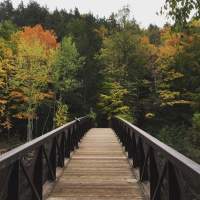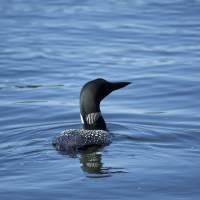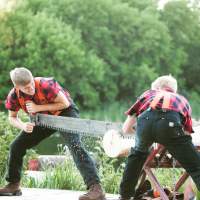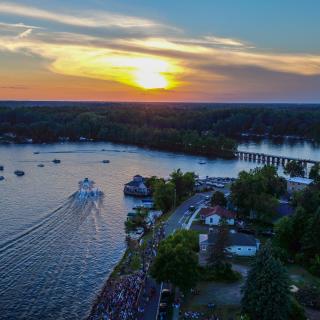Summer is one of the most popular times for visiting the Minocqua area. It is the peak time to take advantage of some of the best area past times, like fishing. Summer fishing the Minocqua area is one of the most productive fishing times but the tricks to catching our most sought after species vary from other times of the year.
Walleye:
The Minocqua area Walleye are commonly sought after throughout the year. From mid June thru the beginning of September. These fish are fantastic table fare and can be caught a variety of ways at several locations on area lakes.
In some of the shallow lakes (under 30 ft deep), the Walleye may spend a great deal of time inside or alongside the weedy sections of the lake. Using a small jig with a medium sized minnow and casting the presentation to the edge of a weed line, allowing the bait to sink down to the bottom and then begin a slow retrieve back to the boat is a popular way to encourage a strike from the Walleye. Maintaining bottom contact is very important. Try not to drag the bait on the bottom as this will create the hook to gather debris. No strike will occur with debris on the hook. Another popular method is to use a slip bobber. This allows the bait to be suspended inside the weeds or just on the edge of the weed growth, a very good presentation and the depth of the bait can easily be adjusted.
On the deeper lakes, fishing the island drop offs, sunken rock bars, and underwater points that extend out into the lake from shore are all good options to drift over with a jig and minnow or a leech or a ½ crawler on a jig as well as bottom bouncing rigs as described above. If there are any storm damaged trees that have fallen into the lake from the shore line, this also can be very productive. Fish the branches that extend out into the deeper water.
As the water temperatures continue to rise throughout the summer, using leeches or nightcrawlers can also be a good option. This live bait can be used with a slip bobber. A bottom bouncer rig, Lindy rig ,or simply a split shot and hook can be utilized too. This will keep the bait close to the bottom and prevent the crawler or leech from collecting debris. A slow retrieve is important.
Another option can be to cast a lure the has the appearance of a minnow bait, a Shad Rap, or a Shad ling and other baits resembling the Perch color pattern as well as gold, silver, chartreuse, purple. Casting these lures during the twilight hours of morning and evening alongside or to the weed line can be very productive. Patience and color experimentation is needed for best results. Also, trolling is a good summer time pattern during the daytime and the twilight hours of each day. The lures mentioned above are a good beginning for this time tested and true method of summertime Walleye fishing. Locations will vary with fish suspended alongside and above different types of underwater structure.
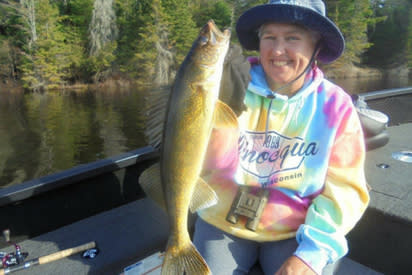
Crappie:
Throughout the Minocqua Chain of Lakes and the surrounding area, during the warmer water of the summer months, casting a small plastic lure commonly called a Tube Jig in a variety of colors or just a colored jig head ( 1/16 oz) with a Crappie minnow attached is a very good presentation. This does work in the spring time as well but, in different locations. This lure and bait choice is very good during summer. A slip bobber is also productive when wanting to keep the bait in one location or at a certain depth and again, this also works in the spring time but, in different locations than summer time.
Fish for the Crappie this time of year around fallen trees that are in deeper water, sunken man made brush piles from 10 to 20 ft deep, the deeper docks and legs of the docks, boat houses that extend over deeper water, weedy areas of the lake that are close to deeper water and also, suspended Crappie. These Crappie are typically away from the shoreline over deeper water but only a few feet below the surface. These suspended Crappie can also be closer to the shoreline if deeper water is close to a shoreline.
Trolling for Crappie is an underutilized technique for summer time. Small minnow baits (one inch in length) trolled slowly, perhaps with a small split shot 12 inches in front of the lure to help the lure reach the selected depth where the suspended Crappie are seen on your sonar unit. The color and the speed of the lure can and usually does make a positive difference in the amount of strikes that will happen.
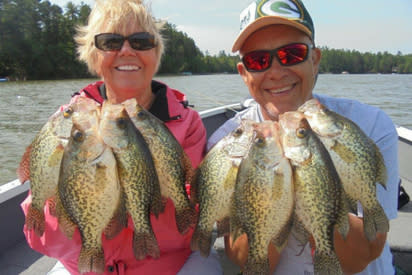
Bluegill:
Bluegill area a very prolific species of fish located in almost every lake. The Minocqua Chain is no exception. These hard fighting little bruisers are what most fishermen were brought up on as youngsters when first learning how to go fishing with Dad or Grandpa. Besides good table fare, they are very easy to catch and selective harvest is important.
A simple old fashioned (small) red and white clip on bobber with a small long shank hook (easy removal from the Bluegills mouth), a small split shot about 10 inches above the hook, and a small piece (1 inch or less) of night crawler and you are all set. Generally set your depth at about 1 to 3 feet. Fish around most docks, weedy areas, shallow rocks, boat lifts, and rocky shorelines.
Small plastic baits used for Crappie also work well but, they should be in an even “smaller size” for the Bluegill as their mouths are very small. As the summer progresses the bigger Bluegill will leave the shore line and remain closer to the weedy areas of the lake and also will be closer to the bottom of those weedy areas including next to the weedy structure.
Perch:
The Minocqua Chain of Lakes has a healthy population of Perch and as all other fish, selective harvest is important for this good eating table fare. Summer time Perch are commonly found in the deeper weeds. There are smaller Perch found in other areas of the lakes but normally the bigger Perch are separate. Seek deeper water, deeper weeds and some rock bars. The soft bottom areas of the lakes also hold summertime Perch as they feed on aquatic larvae.
Crappie minnows on small jigs work well and a small piece of nightcrawler on a small jig 1/16 oz in size also works well with a slow retrieve. Every lake is slightly different with its own characteristics. Different locations of the Perch coincide with each lake, just as other species of fish. Slip Bobbers also work well when wanting to fish at a specific depth. Small lures work for Perch but the small live minnow and a small piece of nightcrawler seem to be the most consistent producer.
Smallmouth Bass:
This species of fish is also very prolific throughout the Minocqua Chain of Lakes and several other area lakes. After these fish lay their eggs and move off the shoreline, their summer time locations are very predictable. Try rock bars, rock points connected to the shoreline, islands, deep logs, deep brush piles, fallen trees into deeper sections of the shoreline, and suspended fish away from the shore line.
The Smallmouth Bass during summer are mostly on the rock bars in deeper water (10 to 30 feet). Using a larger minnow from 2 to 3 inches works well and also a 1/8 oz. or a 1/4 oz. jig with ½ a night crawler works well. There are lure options you can use too such as a floating minnow imitation, spinner bait with a rubber skirt, a jig with a rubber skirt attached, and other selections. Smallmouth Bass are a very hard fighting sport fish and not normally selected for table fare.

Largemouth Bass:
Another popular species of fish in the Minocqua Chain of Lakes are Largemouth Bass. These fish are caught throughout the chain during the middle of the day. Perfect sport fishing for the summer time angler. Casting towards the shoreline is the most popular way of catching them, docks, boat lifts, any shoreline obstruction, bridges, brush piles and weedy bays. Spinner baits with the rubber skirts and 2 blades are a good starting choice and color can make a difference. Plastic worms work as does a jig with a rubber skirt attached. Topwater lures also produce well.
Pick a shoreline or weedy area and start casting. This works and is a time tested and proven way to produce the Largemouth Bass in the Minocqua Chain as well as surrounding lakes.
Musky:
Musky fishing is a highly sought after sport in Minocqua and all surrounding areas. This particular game fish has been a major attraction to the Minocqua area for many, many decades and continues today. The Minocqua Chain provides very good Musky fishing and some very large Musky are caught and released each summer.
Trolling or casting is very popular. Different colored and sized bucktails, large rubber baits such as the Bull Dog and Medusa, crankbaits, topwater baits, and several other baits are used to seduce these giants of the chain.
Rock bars, weed beds, points that extend out into the lake, islands, creek channels, sand bars and suspended Musky are all key target areas for the opportunity to land a big Musky.
This species of fish helped create, in part, the lore of the majestic waters in the Minocqua Wisconsin area.


